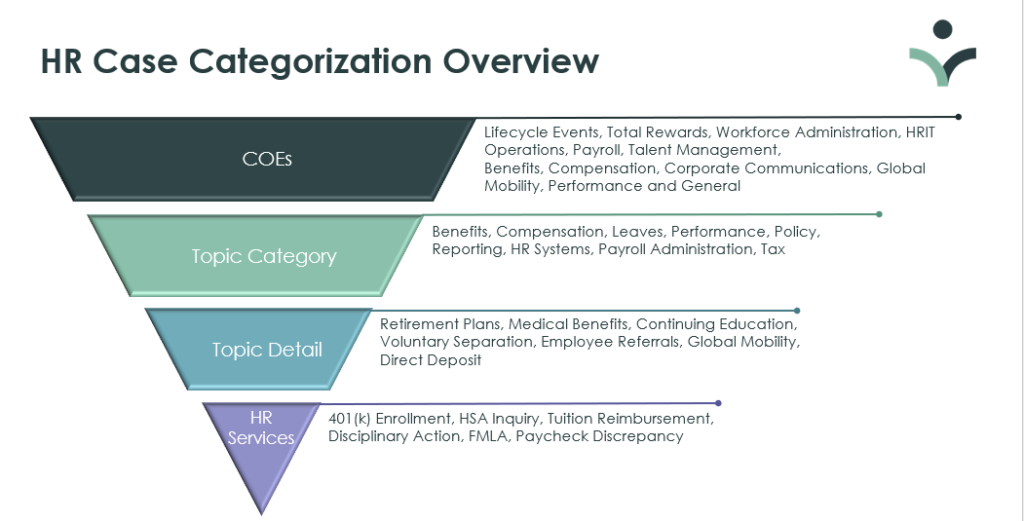Demystifying Taxonomy Categorization
Demystifying Taxonomy Categorization in ServiceNow: Best Practices for Scalable Category Structures evolving at the pace of business requires efficient information organization. At the cornerstone. Taxonomy, a crucial element within ServiceNow. Taxonomy sets in place the important foundations for a structured and easily navigable platform.
This article will unravel the essence of Taxonomy, offering insights into establishing a robust out-of-the-box category/subcategory structure, highlighting potential pitfalls to sidestep, and shedding light on standard Taxonomy structures for ITSM, HRSD, and SecOps. Additionally, we’ll explore the nuanced differences in Taxonomy implementation across Service Catalog, Service Portal, and Employee Service Portal.
Understanding and Demystifying Taxonomy Categorization:
Taxonomy signifies the hierarchical system of classification utilized to organize and categorize records. It acts as a guiding compass, facilitating swift and precise information retrieval. Here are some starter Taxonomy Structures for IT Service Management, HR Service Delivery, and Security Incident Response.
How to build a Service Catalog Taxonomy?
Establishing a Robust Taxonomy Structure
Start with Customer Experience and Business Objectives: Initiate by aligning Taxonomy with the organization’s core business objectives. Grasp the services provided, understand user personas, and discern their primary needs. This foundational step ensures the Taxonomy resonates with the essence of the business.
- Leverage Out-of-the-Box Structures: ServiceNow offers standardized out-of-the-box structures tailored for ITSM, HRSD, and SecOps. These structures serve as excellent starting points, often requiring minimal customization to fit specific organizational needs.
- Employ Descriptive Labels: Clarity and intuitiveness form the bedrock of effective Taxonomy. Labels should be descriptive, steering clear of jargon or technical terms that might alienate users.
- Leverage Category and Subcategory Hierarchy: Categories should represent broad service areas, while subcategories provide more granular distinctions. This hierarchy simplifies navigation, ensuring users find relevant information without unnecessary hassle.
- Incorporate Metadata and Keywords: Augment categories and subcategories with pertinent metadata and keywords. This enhances search capabilities, allowing users to locate information even without traversing the Taxonomy.
Example Taxonomy Structures
Here’s a list of out-of-the-box selectable categories for a few different ServiceNow Solutions. IT Service Management (ITSM), HR Service Delivery (HRSD), and Security Incident Response (SIR).
ITSM Taxonomy
Here is a model Taxonomy that can be used for users to report an ITSM incident, request a service, or search for ITSM knowledge articles in ServiceNow:
ITSM Incident
Something stopped working and needs to be fixed
- Hardware Issues
- Software Errors
- Network Problems
- Access or Login Issues
- Email and Communication
- Printer & Peripheral Issues
- Security and Access Requests
- Phone, Collaboration
- Other (Specify)
ITSM Request
Need to order, request, find, inquire, or get something.
- Hardware Procurement
- Software Install or Upgrade
- Access or Permissions
- Service Account Creation
- Equipment Loan or Rental
- Training and Workshops
- Printer & Peripheral Supplies
- Custom Reporting or Data
- Order Phone, Collaboration
- Other (Specify)
ITSM KB
Self-Service search, support, how do I, Getting Started, FAQs
- Hardware Troubleshooting
- Software FAQs
- Network Guides
- User Access Guides
- Email Setup and Configuration
- Printer Setup /Maintenance
- Security and Access Policies
- Phones, Collaboration
- Other (Specify)
HRSD Taxonomy
Here’s a list of out-of-the-box selectable categories for users to report an HRSD incident, request a service, or search for HRSD knowledge articles in ServiceNow.

Also check out the new Unified Taxonomy in San Diego ServiceNow
HRSD INC
Something stopped working and needs to be fixed
- Benefits Questions
- Payroll & Compensation
- Leave and Time-Off Requests
- Employee Relations Concerns
- Performance Management
- Training and Development
- Policy or Procedure
- Other (Specify)
HRSD REQ
Need to order, request, find, inquire, or get something.
- Benefits Enroll & Change
- Payroll Changes or Updates
- Leave Requests
- New Employee Onboarding
- Performance Review
- Training or Workshop
- Policy Acknowledgment
- Other (Specify)
HRSD KB
Self-Service search, support, how do I, Getting Started, FAQs
- Benefits Information & FAQs
- Payroll & Compensation
- Leave Policy & Procedures
- Employee Relations
- Performance Management
- Training & Development
- HR Policies & Procedures
- Other (Specify)
SIR/VR Taxonomy
Here’s a list of out-of-the-box selectable categories for users to report an HRSD incident, request a service, or search for HRSD knowledge articles in ServiceNow:
SIR/VR INC
Something stopped working and needs to be fixed
- Unauthorized Access
- Malware or Virus
- Phishing or Social Engineering
- Lost or Stolen Device
- Data Breach
- Physical Security Incident
- Suspicious Activity
- Other (Specify)
SIR/VR REQ
Need to order, request, find, inquire, or get something.
- Security Access Request
- Antivirus Security Software
- Security Awareness Training
- Device Encryption Request
- Incident Investigation Request
- Vulnerability Assessment
- Policy or Procedure Request
- Other (Specify)
SIR/VR KB
Self-Service search, support, how do I, Getting Started, FAQs
- Security Best Practices
- Incident Response Process
- Vulnerability Remediation
- Security Policy & Compliance
- Security Awareness Tips
- Malware Detection & Prevention
- Phishing Awareness
- Other (Specify)
Pitfalls to Avoid
Overcomplicating the Structure: While granularity is pivotal, an excessively complex Taxonomy can lead to confusion. Avoid excessive subcategories or cryptic labels.
Neglecting User Feedback: User preferences and needs evolve over time. Regularly seeking and incorporating user feedback refines the Taxonomy for optimal usability.
Ignoring Search Optimization: A well-structured Taxonomy should complement, not replace, robust search functionality. Neglecting search optimization can lead to frustration and inefficiency.
Distinctions Across Portals
Service Catalog: The Service Catalog encompasses the spectrum of service offerings available to users. Here, Taxonomy aids users in swiftly locating and requesting the services they require.
Service Portal: The Service Portal constitutes the user-facing front end of ServiceNow. Taxonomy in the Service Portal mirrors that of the Service Catalog, ensuring a seamless experience.
Employee Service Portal: This portal caters specifically to employee needs. Taxonomy here may include HR-specific categories and subcategories, aligning with the unique requirements of the workforce.
Setting up Taxonomy for AI, Machine Learning, and Chatbots
In the rapidly advancing landscape of technology, integrating AI, Machine Learning, and Chatbots into your ServiceNow platform can revolutionize user interactions and streamline workflows. Properly configuring Taxonomy for these components is crucial to ensure they operate effectively and provide maximum value. Here’s a comprehensive guide on how to set up Taxonomy for AI, Machine Learning, and Chatbots:
Understand User Intent and Interaction Scenarios:
Begin by comprehensively understanding the potential user intents and interaction scenarios that AI, Machine Learning, and Chatbots will handle within your ServiceNow environment.
Identify Relevant Categories and Subcategories:
Based on the user intents and scenarios, identify the relevant categories and subcategories that will house the interactions with AI, Machine Learning, and Chatbots.
Define Clear Labels:
Ensure that the labels for these categories and subcategories are clear, intuitive, and reflective of the specific functions they perform. Avoid technical jargon that may confuse users.
Integrate with Existing Taxonomy:
Seamlessly integrate the Taxonomy for AI, Machine Learning, and Chatbots with the existing Taxonomy structure in ServiceNow. This ensures a cohesive user experience across all aspects of the platform.
Incorporate Metadata for Training and Analysis:
Include relevant metadata that aids in the training of AI and Machine Learning models. This metadata should provide context to enhance the accuracy of responses.
Link Taxonomy with Chatbot Intents and Entities:
Establish a clear link between Taxonomy categories and the intents and entities defined for your Chatbot. This association enables the Chatbot to accurately understand and respond to user queries.
Enable Continuous Learning:
Implement mechanisms for continuous learning and improvement. Regularly analyze user interactions and update the Taxonomy, as needed, to enhance the performance of AI, Machine Learning, and Chatbots.
User Feedback Loop:
Establish a feedback loop to gather user input on the interactions with AI, Machine Learning, and Chatbots. Use this feedback to refine Taxonomy and improve user experiences.
Optimize for Search and Suggestions:
Ensure that the Taxonomy for AI, Machine Learning, and Chatbots is optimized for search functionality. This allows users to easily find and engage with these features.
Monitor Performance Metrics:
Track key performance metrics related to AI, Machine Learning, and Chatbot interactions. Use this data to make informed adjustments to the Taxonomy and improve overall system performance.
Resources: Demystifying Taxonomy Categorization
- Service Catalog/Portal A-Z Glossary
- Service Catalog Process FAQs
- ServiceNow HRSD: Topic Categories vs Employee Center Taxonomy Topics
- User Experience (UX) Terms: A to Z Glossary | Coursera
- Using Task Intelligence, use AI to categorize cases
- What is the best approach to service catalogue taxonomy- ServiceNow Community?
-
Getting Started
- AI: ServiceNow Virtual-Agent Chatbot
- BMC Remedy ITSM Reference
- Burp Suite Professional & Web Security Process
- COE for Human Resources
- Conduct A Windows-Security Scan
- Employee Journey Management ServiceNow
- Getting Started: Engagement Manager
- Introduction to Knowledge Management
- Knowledge Categorization "Find-ability"
- One-IT: Effective Ticket Handling
- Productivity Tips for Knowledge-Users
- Productivity: Service Operations Workspace
- Quick Start Guide
- Service Catalog Order Guides
- Your Next Steps
-
- Advanced Program Management
- AI: ServiceNow Virtual-Agent Chatbot
- Artificial Intelligence A-Z Glossary
- Business Process Optimization Reviews
- Category Hierarchy and Tabs Layout
- Employee Journey Management ServiceNow
- GE Change Acceleration Process
- GRC Managed Risk
- Overview: Employee Center Pro
- Productivity: Service Operations Workspace
- Proper Ticket Handling Imperative
- Public Sector Digital Services
- RIDAC: Strategic Portfolio Management
- SOX Control-Management and Attestation
-
- Articles coming soon
-
FAQs
- Best of ServiceNow Vancouver
- Chat GPT FAQS
- DevOps & Change Velocity
- Enhancing End-User Service Experience
- FAQs: Governance Risk Compliance
- How-To Import ServiceNow Stories 🚀
- Knowledge Categorization "Find-ability"
- Role of CMDB-Management Service-Owner
- Service Catalog Process FAQs
- ServiceNow IRM SOX FAQs
- Strategic Portfolio Management FAQs
- Ticket Handling Infographic FAQs
- Understanding Clop Ransomware Mitigation
- Vulnerability Response Workspace Module
- Washington ESC or Knowledge Portal?
-
- AI & GRC Defense Against Security-Data Breach
- AI and Improved Knowledgebase-Search
- AI Revolutionizes Service Management
- AutomatePro AutoTest Custom-Testing
- AutomatePro AutoTest: Getting Started
- Best of ServiceNow Vancouver
- CMDB Health Dashboard
- Comparing ServiceNow-Strategic-PM to Microsoft-PM
- Demystifying Taxonomy Categorization
- DevOps & Change Velocity
- Efficient Workday to ServiceNow Integration
- Email-to-Incident is Costly Inefficiency
- Enhancing End-User Service Experience
- Financial Services Operations
- Gamifying ITSM Excellence
- GRC Industry Reference Matrix
- Introducing Security Incident Response
- Role of CMDB-Management Service-Owner
- Service Catalog Process FAQs
- ServiceNow Executive Reporting Approaches
- ServiceNow Virtual Agent Chatbot
- SPM Gantt Chart Presentation
- Strategic Portfolio Management FAQs
- Vulnerability Response Test Plan
- Vulnerability Response Workspace Module
- Washington ESC or Knowledge Portal?
- Show Remaining Articles11 Collapse Articles
-
Glossary Reference
-
Blog
- 2021: VP Harris Inauguration Elevates Diversity and Executive Leadership
- 5-Star ITSM Solutions
- 5-Step Policy-Compliance Risk Management
- AI & GRC Defense Against Security-Data Breach
- AI Revolutionizes Service Management
- AI: Knowledge Centered Support
- ChatGPT Ethics and FTC
- CMDB Corporate Governance for Publicly Held Companies
- Community Crisis Resource Reference List
- Covid Cyber Employment Fraud: $Millions in Job Fraud, $Billions in Unemployment Fraud. Recruiters and Jobseekers Paradigm shift
- Does Post Covid Demand, "Evolve or Fold" Data Strategy?
- Financial Services Operations
- Freshwork's Multichannel vision for FreshService (ITSM)
- Gamifying ITSM Excellence
- GRC Industry Reference Matrix
- Imperative: Governance Risk Compliance
- Jobs n Career Success: Employment News
- Microsoft Teams Tripping Transcription Tenancy.
- Predictive Intelligent Situational Awareness
- Remedy to ServiceNow Migration
- Review and Approve Knowledge
- ROI: Demand AI Service Management
- Top Trends in Project Management
- Uber's Call Center Security Social Engineering Massive System Breach
- Vulnerability Remediation RACI
- Walk Up Experience- Design-To-Deliver
- World Talent Economy Forum on Global Competitiveness
- Show Remaining Articles12 Collapse Articles
-
Healthcare
-
Workday
-
Network Connectivity Solutions
-
Business Process Methodologies

